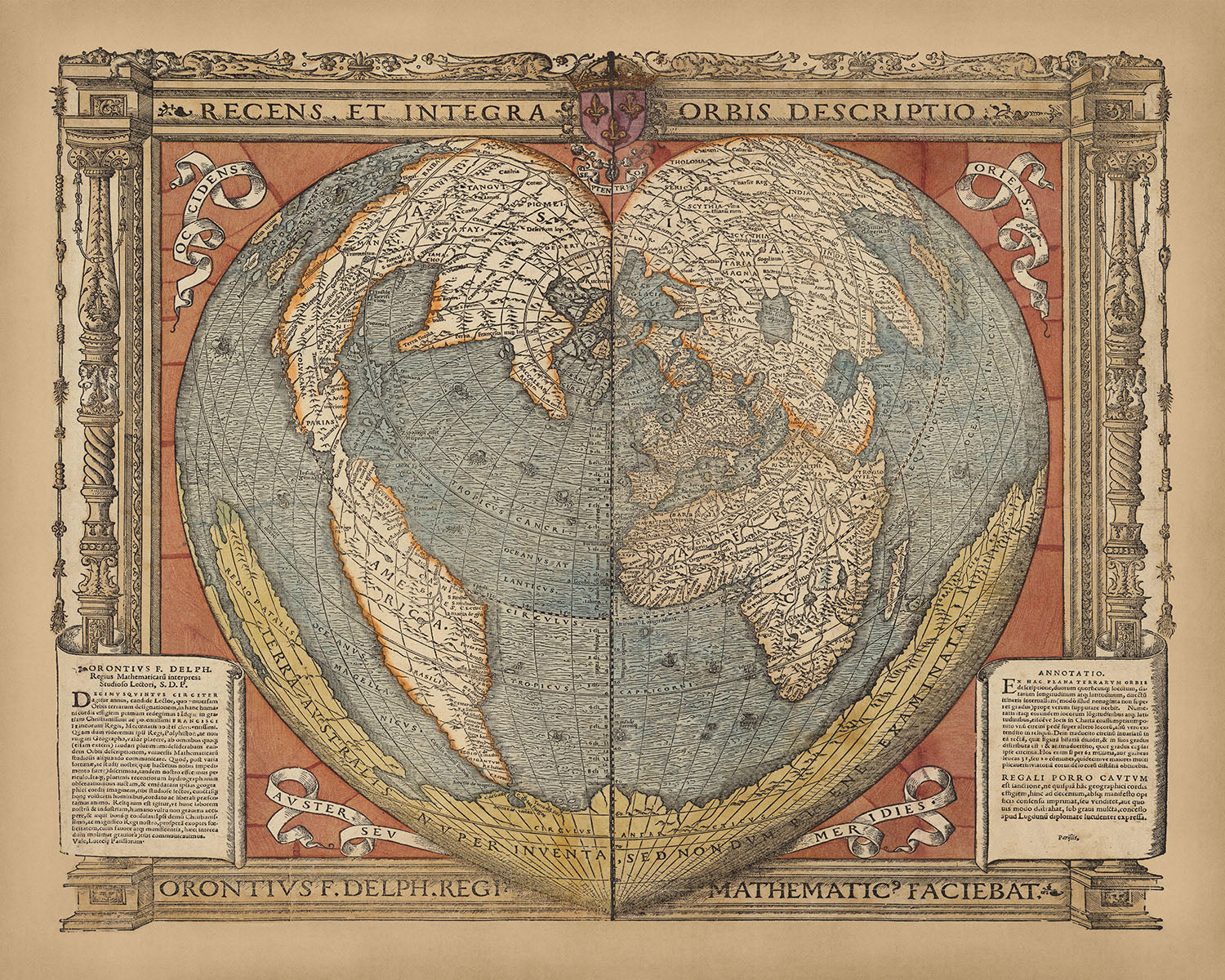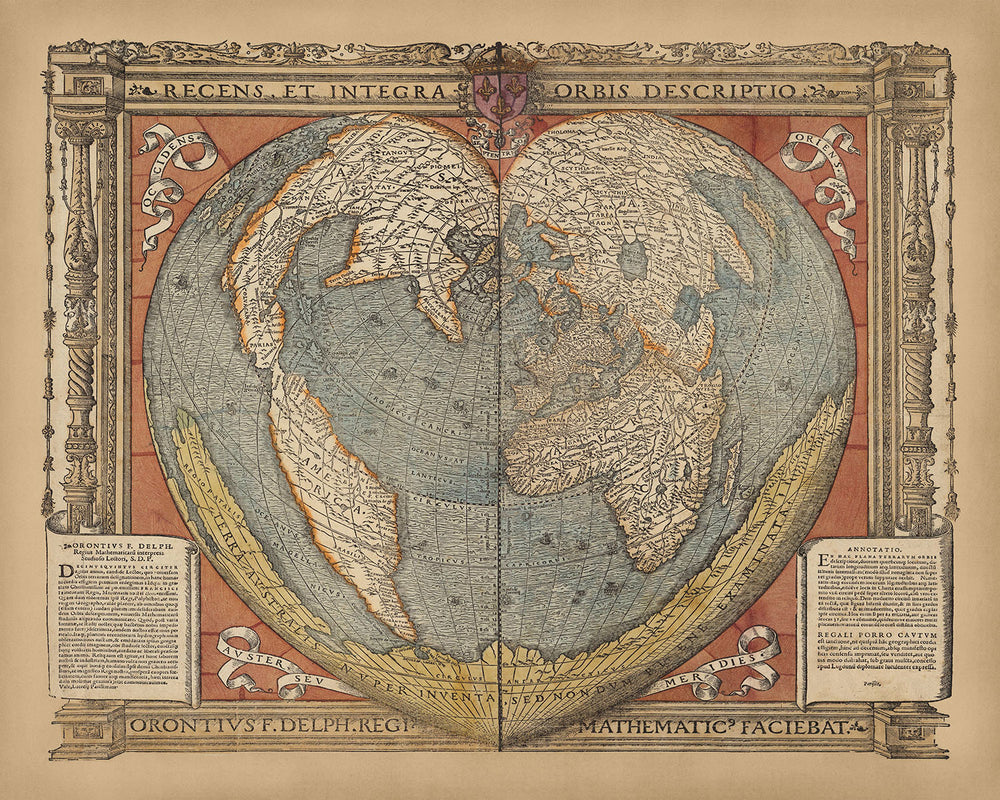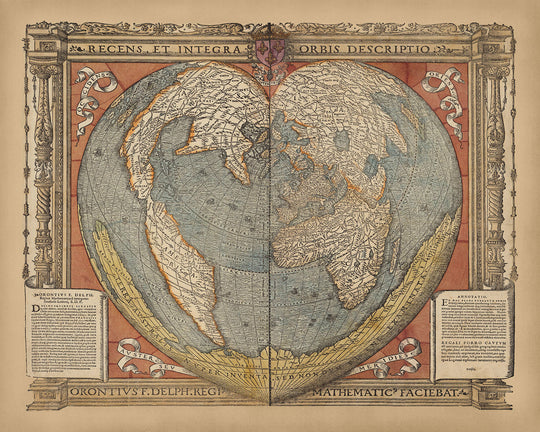- Handmade locally. No import duty or tax
- FREE worldwide delivery
- Love it or your money back (90 days)
- Questions? WhatsApp me any time
Own a piece of history
5,000+ 5 star reviews


A Modern and Complete Map of the World by the Royal Mathematician Oronce Fine of the Dauphiné, created in 1534, is a masterpiece of Renaissance cartography. Oronce Fine, an eminent French astronomer and mathematician, was one of the pioneering scholars in the field of cartography. His expertise in mathematics and astronomy is evident in this exquisite map, which reflects the state of geographic knowledge and the prevailing hypotheses of the 16th century. Fine’s map is not merely a geographical representation but a testament to the intellectual curiosity and scientific endeavors of its time.
The map’s heart-shaped design, known as a cordiform projection, is both aesthetically pleasing and scientifically significant. This innovative projection was inspired by the second-century geographer Ptolemy and later codified by Johannes Werner in 1514. The heart shape symbolizes the world as a living entity, reflecting the Renaissance's humanistic spirit. Fine’s use of this projection showcases his mathematical prowess and his ability to blend art with science, creating a map that is as beautiful as it is informative.
One of the most intriguing aspects of Fine’s map is its depiction of North America as joined with Asia, a common misconception of the era. This reflects the limited exploration and understanding of the New World at the time. Additionally, the map features a vast Terra Australis, a hypothetical southern continent that geographers believed must exist to balance the northern land masses. These geographic hypotheses highlight the adventurous spirit of the age and the ongoing quest for knowledge and discovery.
The map is adorned with intricate details and annotations in Latin, providing context and explanations that enhance its historical value. Decorative borders, cartouches, and illustrations of scrolls with Latin inscriptions add to its visual appeal. The inclusion of ships and sea creatures in the oceans not only adds a whimsical touch but also serves as a reminder of the maritime explorations that were expanding the known world.
Historically, this map holds significant value as it was part of the collection of the renowned geographer Jean-Baptiste Bourguignon d'Anville. It was later purchased by King Louis XVI in 1779 and eventually deposited in the National Library of France in 1924. This provenance adds to its prestige and underscores its importance as a historical artifact. Owning a piece like this is not just about possessing a map; it is about holding a fragment of history, a testament to human curiosity and the relentless pursuit of knowledge.
Countries and regions on this map
- Continents:
- North America
- South America
- Europe
- Africa
- Asia
-
Terra Australis (hypothetical southern continent)
-
Regions/Countries:
- Various regions and countries within the continents are depicted, though specific modern-day country names may not be clearly labeled or recognizable due to the map's age and the state of geographic knowledge at the time.
Notable Features & Landmarks
- Bodies of Water:
- Various seas and oceans are depicted, including the Atlantic Ocean and the Indian Ocean.
- Mountain Ranges:
- Several mountain ranges are illustrated, though specific names may not be clearly labeled.
- Additional Illustrations:
- Decorative borders and cartouches.
- Illustrations of scrolls with Latin inscriptions.
- Historical Notes/Annotations:
- Annotations in Latin are present on the map, providing context and explanations.
- Other Interesting Features:
- The map includes a decorative coat of arms at the top center.
- Detailed illustrations of ships and sea creatures in the oceans.
Historical and design context
- Creation Date: 1534
- Mapmaker/Publisher: Oronce Fine, an astronomer and mathematician, who was the first chair of mathematics in the Collège Royal (present-day Collège de France) from 1531.
- Interesting Context about the Mapmaker: Oronce Fine was one of the first French scholars to work with cartography. His expertise in mathematics and astronomy significantly influenced his cartographic work.
- Design/Style of the Map: The map is in the shape of a heart, known as a "cordiform projection." This design was inspired by the second-century geographer Ptolemy and was codified by Johannes Werner, a mathematician in Nuremberg, in 1514.
- Historical Significance:
- The map reflects the state of knowledge and geographic hypotheses and uncertainties of its day.
- North America is depicted as joined with Asia.
- A vast Terra Australis, a hypothetical continent posited to counterbalance the weight of the northern land masses, is drawn in the south.
- The map is from the collection of the geographer Jean-Baptiste Bourguignon d'Anville and was purchased by King Louis XVI in 1779. It was deposited in the National Library of France in 1924.
- Topics and Themes:
- Geographic Knowledge: The map showcases the geographic understanding and misconceptions of the 16th century.
- Cartographic Innovation: The heart-shaped projection is a notable innovation in the history of cartography.
Please double check the images to make sure that a specific town or place is shown on this map. You can also get in touch and ask us to check the map for you.
This map looks great at every size, but I always recommend going for a larger size if you have space. That way you can easily make out all of the details.
This map looks amazing at sizes all the way up to 50in (125cm). If you are looking for a larger map, please get in touch.
The model in the listing images is holding the 16x20in (40x50cm) version of this map.
The fifth listing image shows an example of my map personalisation service.
If you’re looking for something slightly different, check out my collection of the best old maps to see if something else catches your eye.
Please contact me to check if a certain location, landmark or feature is shown on this map.
This would make a wonderful birthday, Christmas, Father's Day, work leaving, anniversary or housewarming gift for someone from the areas covered by this map.
This map is available as a giclée print on acid free archival matte paper, or you can buy it framed. The frame is a nice, simple black frame that suits most aesthetics. Please get in touch if you'd like a different frame colour or material. My frames are glazed with super-clear museum-grade acrylic (perspex/acrylite), which is significantly less reflective than glass, safer, and will always arrive in perfect condition.
This map is also available as a float framed canvas, sometimes known as a shadow gap framed canvas or canvas floater. The map is printed on artist's cotton canvas and then stretched over a handmade box frame. We then "float" the canvas inside a wooden frame, which is available in a range of colours (black, dark brown, oak, antique gold and white). This is a wonderful way to present a map without glazing in front. See some examples of float framed canvas maps and explore the differences between my different finishes.
For something truly unique, this map is also available in "Unique 3D", our trademarked process that dramatically transforms the map so that it has a wonderful sense of depth. We combine the original map with detailed topography and elevation data, so that mountains and the terrain really "pop". For more info and examples of 3D maps, check my Unique 3D page.
For most orders, delivery time is about 3 working days. Personalised and customised products take longer, as I have to do the personalisation and send it to you for approval, which usually takes 1 or 2 days.
Please note that very large framed orders usually take longer to make and deliver.
If you need your order to arrive by a certain date, please contact me before you order so that we can find the best way of making sure you get your order in time.
I print and frame maps and artwork in 23 countries around the world. This means your order will be made locally, which cuts down on delivery time and ensures that it won't be damaged during delivery. You'll never pay customs or import duty, and we'll put less CO2 into the air.
All of my maps and art prints are well packaged and sent in a rugged tube if unframed, or surrounded by foam if framed.
I try to send out all orders within 1 or 2 days of receiving your order, though some products (like face masks, mugs and tote bags) can take longer to make.
If you select Express Delivery at checkout your order we will prioritise your order and send it out by 1-day courier (Fedex, DHL, UPS, Parcelforce).
Next Day delivery is also available in some countries (US, UK, Singapore, UAE) but please try to order early in the day so that we can get it sent out on time.
My standard frame is a gallery style black ash hardwood frame. It is simple and quite modern looking. My standard frame is around 20mm (0.8in) wide.
I use super-clear acrylic (perspex/acrylite) for the frame glass. It's lighter and safer than glass - and it looks better, as the reflectivity is lower.
Six standard frame colours are available for free (black, dark brown, dark grey, oak, white and antique gold). Custom framing and mounting/matting is available if you're looking for something else.
Most maps, art and illustrations are also available as a framed canvas. We use matte (not shiny) cotton canvas, stretch it over a sustainably sourced box wood frame, and then 'float' the piece within a wood frame. The end result is quite beautiful, and there's no glazing to get in the way.
All frames are provided "ready to hang", with either a string or brackets on the back. Very large frames will have heavy duty hanging plates and/or a mounting baton. If you have any questions, please get in touch.
See some examples of my framed maps and framed canvas maps.
Alternatively, I can also supply old maps and artwork on canvas, foam board, cotton rag and other materials.
If you want to frame your map or artwork yourself, please read my size guide first.
My maps are extremely high quality reproductions of original maps.
I source original, rare maps from libraries, auction houses and private collections around the world, restore them at my London workshop, and then use specialist giclée inks and printers to create beautiful maps that look even better than the original.
My maps are printed on acid-free archival matte (not glossy) paper that feels very high quality and almost like card. In technical terms the paper weight/thickness is 10mil/200gsm. It's perfect for framing.
I print with Epson ultrachrome giclée UV fade resistant pigment inks - some of the best inks you can find.
I can also make maps on canvas, cotton rag and other exotic materials.
Learn more about The Unique Maps Co.
Map personalisation
If you're looking for the perfect anniversary or housewarming gift, I can personalise your map to make it truly unique. For example, I can add a short message, or highlight an important location, or add your family's coat of arms.
The options are almost infinite. Please see my map personalisation page for some wonderful examples of what's possible.
To order a personalised map, select "personalise your map" before adding it to your basket.
Get in touch if you're looking for more complex customisations and personalisations.
Map ageing
I have been asked hundreds of times over the years by customers if they could buy a map that looks even older.
Well, now you can, by selecting Aged before you add a map to your basket.
All the product photos you see on this page show the map in its Original form. This is what the map looks like today.
If you select Aged, I will age your map by hand, using a special and unique process developed through years of studying old maps, talking to researchers to understand the chemistry of aging paper, and of course... lots of practice!
If you're unsure, stick to the Original colour of the map. If you want something a bit darker and older looking, go for Aged.
If you are not happy with your order for any reason, contact me and I'll get it fixed ASAP, free of charge. Please see my returns and refund policy for more information.
I am very confident you will like your restored map or art print. I have been doing this since 1984. I'm a 5-star Etsy seller. I have sold tens of thousands of maps and art prints and have over 5,000 real 5-star reviews. My work has been featured in interior design magazines, on the BBC, and on the walls of dozens of 5-star hotels.
I use a unique process to restore maps and artwork that is massively time consuming and labour intensive. Hunting down the original maps and illustrations can take months. I use state of the art and eye-wateringly expensive technology to scan and restore them. As a result, I guarantee my maps and art prints are a cut above the rest. I stand by my products and will always make sure you're 100% happy with what you receive.
Almost all of my maps and art prints look amazing at large sizes (200cm, 6.5ft+) and I can frame and deliver them to you as well, via special oversized courier. Contact me to discuss your specific needs.
Or try searching for something!















































